Want to save a Search? Learn how to save Windows Explorer Search Results in Windows 11/10 to save time in searching the same parameters again. Windows OS allows us to search any files on our PC. The File Explorer helps you quickly access your desktop content, downloads, saved documents, music, pictures, videos, and other content from a centralized location. It has a unique ‘Search‘ feature that helps you browse folders on your system for specific files or documents. When we want to find some files, and if we are unsure of the location, then the Search function comes in handy. To search for a specific file on our PC, we perform an Advanced Search using parameters like file extension, date modified, keywords, date range, and many more options. But when we want to search files that include the same options every time, then it is time-consuming doing the same thing again and again. So, in this post, I will let you know how to save a Search in Windows so that you can perform a search without retyping the entire search criteria again.
How to Save A Search in Windows 11/10

If you want to browse files quickly, you can use the Windows Explorer Search feature. If you think you might repeat the same search in the future, you can save Windows Explorer search results. We will show you how to do this.
How to save Windows Explorer Search Results by creating a Shortcut in Windows 11/10
Your File Explorer searches are saved at C:\Users\[user_profile]\Searches by default. You can create a desktop shortcut for these searches to access them anytime in the future. Here’s how you can do this:
- Launch the Windows File Explorer.
- Select the folder from the left panel where you’d like to perform the search.
- Type your search query in the search bar in the top-right corner of the File Explorer window.
- Press the Enter key. Search results will show up.

- Right-click anywhere in the empty space of the results pane and select Show more options > Save search.
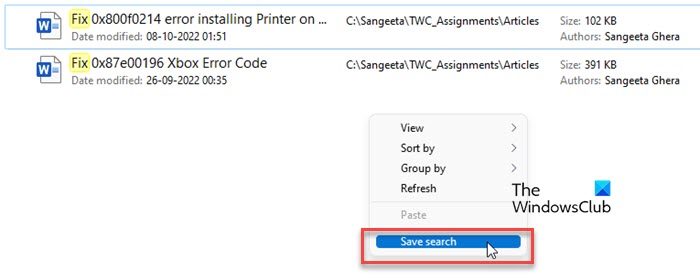
- Give a suitable name to the file.
- Click on the Save button.
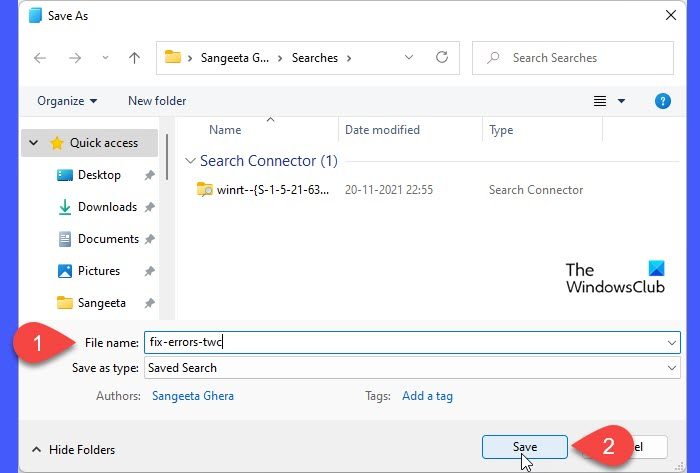
- Navigate to C:\Users\[user_profile]\Searches.
- Right-click on the saved search.
- Select Show more options > Send to > Desktop (create shortcut).
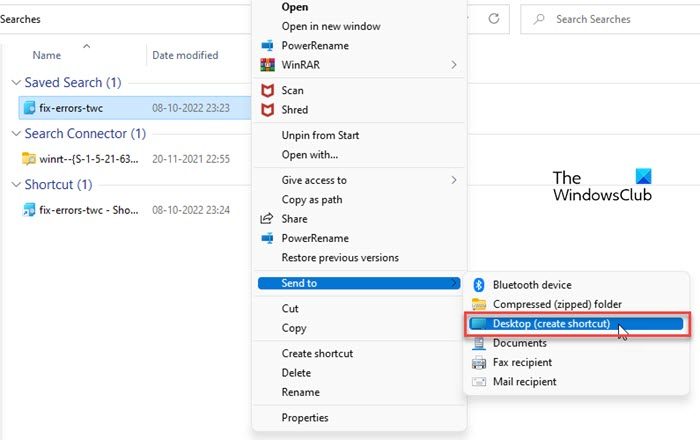
A shortcut to quickly launch the search will appear on your desktop. When you click on this shortcut anytime in the future, the results will be updated to include all new files that match the search query.
Tip: You can also pin the search to your Start button menu by right-clicking on the saved search and selecting the Pin to Start option.
This is how you can save Windows Explorer search results. Hope you find this interesting. Keep reading our blogs for more Windows tips and tricks. Do not forget to share your feedback or queries in the comments section below.
Read:
How to save/export Windows Explorer search results as a TXT or CSV file?
You can save or export Windows Explorer search results to a Notepad or Excel file. This allows you to save the exact paths of the search results for future reference. Here’s how to do it:
- Search for anything in the Windows File Explorer.
- When the search results appear, press the Ctrl+A key combination to select all results.
- Press the Shift key, hold it, and right-click on the selected results.
- Select Show more options > Copy as Path from the context menu.
- Open Notepad/Excel.
- Paste the copied results in a new Notepad/Excel file.
- Save the file with a suitable name at the location of your choice.
How to save a Search in Windows 7
If you want to search certain types of files regularly, then it is advised to save the search for easy access. Saving the Search does not depend on the number of parameters you have added or where you perform the search. It is very simple and easy and let us see how it is done.
Perform the search in any File Explorer with the parameters you want.
Now, you will see the “Search” tab, and under it, “Save Search”.
Click on Save Search.
Give it the name you want so that you can identify the search parameters easily.
By default, it gets saved in “C:\users\<username>\Searches” folder in Windows 11/10/8. In Windows 7, saved searches are found in “Favorites” folder. But you can save the search anywhere you want.
You can also save the search by dragging the icon present in the address bar to the location where you want.
If you save the search by doing so, then Windows will create the shortcut to the search. Double-clicking on the shortcut will perform the search.
So, when you want to search for a file that meets the criteria of the saved search, just double-click on the saved search. This will fire the search in the file explorer and you can see the search results.
Pin the Saved search to Start Menu
Now, here comes the handy feature in Windows 10. If you are using Windows 10, then you can pin the saved search to the Start menu. Right-click on the search you have saved and click “Pin to Start” from the options shown in the context menu.
You can see the pinned search in the Start menu.
This is the way to save a search on a Windows PC.
Where are Windows Searches stored?
The search queries in the Windows File Explorer can be saved using the Save Search feature in Windows 11/10. This feature saves the query in XML format in a virtual folder called the Search Folder. The XML file contains information such as what to search for, where to search, and how to present the search results. When you open a Search Folder, it runs the query and displays fresh results, including new files and folders that match the search criteria. By default, it gets saved in “C:\users\<username>\Searches” folder in Windows 11/10.
Read Next: Best free Windows Search Alternative Tools for Windows 11.
This post will show you how to delete Windows Search History or re-create deleted Searches folder.
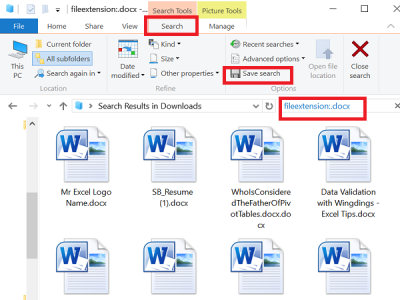
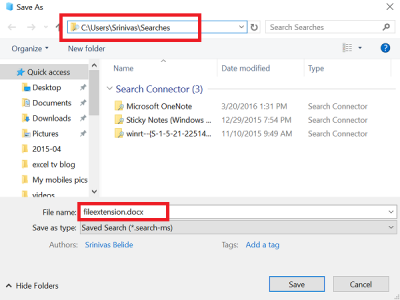

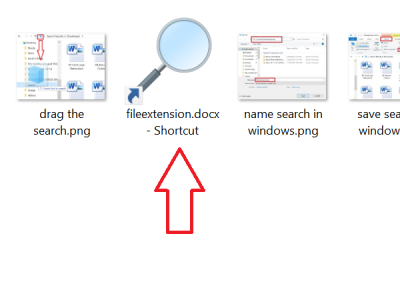
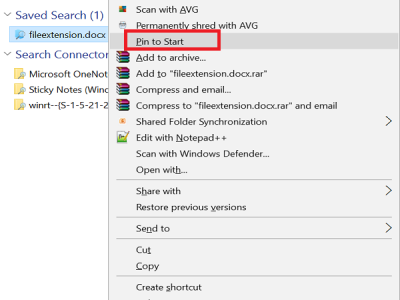
Gostaria de adicionar a busca no quick access!!!